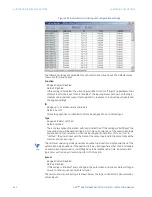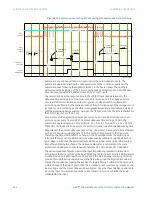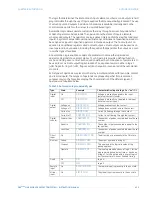
474
D90
PLUS
LINE DISTANCE PROTECTION SYSTEM – INSTRUCTION MANUAL
AUTOMATION LOGIC
CHAPTER 8: AUTOMATION
Figure 402: UR
Plus
-series architecture overview
The states of all digital signals used in the D90
Plus
are represented by flags (or automation
logic operands, described later in this section). A logic 1 state is represented by a set flag.
Any external contact change-of-state can be used to block an element from operating, as
an input to a control feature in an automation logic equation, or to operate a contact
output. The state of the contact input can be displayed locally or viewed remotely via the
communications facilities provided. If a simple scheme where a contact input is used to
block an element is desired, this selection is made when programming the element. This
capability also applies to the other features that set flags: elements, virtual inputs, remote
inputs, schemes, and human operators.
If more complex logic than presented above is required, it is implemented via automation
logic. For example, if it is desired to have the closed state of contact input H7a and the
operated state of the phase undervoltage element block the operation of the breaker
control element, the two control input states are programmed in an automation logic
equation. This equation ANDs the two control inputs to produce a virtual digital output,
which is then selected when programming the phase time overcurrent to be used as a
blocking input. Virtual digital outputs can only be created by automation logic equations.
Traditionally, protective relay logic has been relatively limited. Any unusual applications
involving interlocks, blocking, or supervisory functions had to be hard-wired using contact
inputs and outputs. Automation logic minimizes the requirement for auxiliary components
and wiring while making more complex schemes possible.
9LUWXDORXWSXWV
(OHPHQWV«
)OH[/RJLF
9LUWXDODQDORJV
'DWDORJJHU
V\QFKURSKDVRUV
3URWHFWLRQ
3URWHFWLRQDQDORJYDOXHV
)OH[$QDORJYDOXHV
3URWHFWLRQRSHUDQGV
9LUWXDOLQSXWV
6KDUHGRSHUDQGV
$XWRPDWLRQ
9LUWXDODQDORJYDOXHV
)OH[$QDORJYDOXHV
(OHPHQWV«
$XWRPDWLRQORJLF
$XWRPDWLRQRSHUDQGV
9LUWXDOLQSXWV
6KDUHGRSHUDQGV
'LJLWDOIDXOWUHFRUGHU
)OH[$QDORJYDOXHV
(TXLSPHQWPDQDJHU
6KDUHGRSHUDQGV
0HWHULQJ
)UR0,
5HPRWH
LQSXWV
$XWRPDWLRQ
FRQWDFW
LQSXWV
3URWHFWLRQ
FRQWDFW
LQSXWV
&7VDQG97V
'63
$XWRPDWLRQ
FRQWDFW
RXWSXWV
$&'5
)OH[$QDORJV
9LUWXDORXWSXWV
3URWHFWLRQRSHUDQGV
6KDUHGRSHUDQGV
7UDQVLHQWUHFRUG
'LVWXUEDQFHUHFRUG
)DXOWUHSRUW
%DWWHU\PRQLWRU
%UHDNHUDUFLQJ
)OH[$QDORJYDOXHV
6KDUHGRSHUDQGV
3URWHFWLRQRSHUDQGV
$XWRPDWLRQRSHUDQGV
0HWHULQJRSHUDQGV
(TXLSPHQWPDQDJHURSHUDQGV
$QQXQFLDWRU
0LPLFGLDJUDP
6KDUHG
RSHUDQGV
3URWHFWLRQ
FRQWDFW
RXWSXWV
7HOHSURWHFWLRQ
LQSXWV
'LUHFW
LQSXWV






































